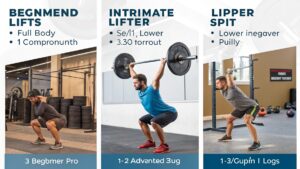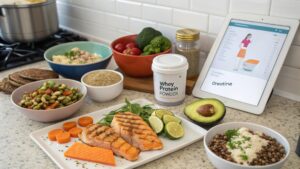Introduction
If you’re searching for a Beginner to Pro: A Step‑by‑Step Gym Plan for Building Lean Mass Fast, you’ve landed in the right place. This guide blends proven training principles, nutrition strategies, and recovery hacks into a clear roadmap that takes you from the first time you pick up a dumbbell to a seasoned, muscle‑building powerhouse—in record time. Let’s unlock the secrets to rapid, sustainable lean mass growth together.
Foundations of Muscle Growth: Hormones, Mechanics & Nutrition
Understanding the Science of Hypertrophy
Muscle hypertrophy isn’t magic; it’s a physiological response to mechanical tension, metabolic stress, and muscle damage. When you subject muscle fibers to progressive overload, you trigger micro‑tears that, with proper nutrition and rest, rebuild stronger and larger. The key hormones—testosterone, growth hormone, and insulin‑like growth factor‑1 (IGF‑1)—are amplified by heavy, compound lifts and adequate protein intake, creating an optimal anabolic environment.
Why Protein is the Cornerstone of Lean Mass
Protein supplies the essential amino acids needed for muscle protein synthesis (MPS). Research shows that consuming 0.7‑1.0 g of protein per pound of body weight daily maximizes MPS, especially when spread across 4‑6 meals. Prioritize high‑quality sources (whey, chicken breast, lean beef, eggs, and plant‑based options like pea or soy) and aim for 20‑30 g of protein per feeding to keep the muscle‑building clock ticking.
Caloric Surplus Without Gaining Unwanted Fat
A modest calorie surplus of 250‑500 kcal above maintenance fuels growth while limiting fat accumulation. Use an online calculator to estimate your maintenance calories, then add the surplus. Adjust weekly based on weight trends: if you’re gaining more than 0.5 lb (0.2 kg) per week, trim 100 kcal; if you’re stagnant, add another 100‑150 kcal.
Structuring the Workout Program: From Full‑Body Basics to Pro Split

Weeks 1‑4 – Full‑Body Foundations (Beginners)
During the first month, focus on three full‑body sessions per week (e.g., Monday, Wednesday, Friday). Each session includes two compound lifts (squat, deadlift, bench press, overhead press, or pull‑up) followed by accessory work targeting the same muscle groups. Perform 3‑4 sets of 8‑12 reps per compound movement, emphasizing perfect form and controlled tempo. This frequency maximizes neural adaptations and builds a solid strength base.
Weeks 5‑8 – Upper/Lower Split (Intermediate)
Transition to four sessions: two upper‑body days and two lower‑body days. This split allows you to increase volume while still providing ample recovery. Example routine:
• Upper A – Bench press, bent‑over rows, incline dumbbell press, lat pull‑downs, triceps extensions, biceps curls.
• Lower A – Back squat, Romanian deadlift, leg press, calf raise, core work.
Aim for 4‑5 sets of 6‑10 reps on the main lifts and 3‑4 sets of 10‑15 reps on accessories. Add progressive overload each week (2‑5 lb increase or an extra rep).
Weeks 9‑12 – Push/Pull/Legs (Advanced)
By the third month, shift to a five‑day Push/Pull/Legs (PPL) routine to specialize muscle groups and push hypertrophy ceilings. Example:
• Day 1 – Push (bench press, overhead press, dips, lateral raises).
• Day 2 – Pull (deadlift, pull‑ups, barbell rows, face pulls).
• Day 3 – Legs (front squat, leg curl, lunges, calf raises).
Repeat the cycle, adjusting volume to 4‑6 sets of 4‑8 reps for heavy compounds and 3‑5 sets of 12‑15 reps for isolation. This split mirrors the “pro” phase, delivering the stimulus needed for rapid lean mass gains.
Nutrition Blueprint: Meal Planning, Timing & Supplements

Meal Timing for Maximum Anabolic Response
While total daily protein and calories drive growth, timing can fine‑tune results. Consume a protein‑rich meal within 30‑60 minutes post‑workout to capitalize on the “muscle‑protein synthesis window.” Pair 20‑30 g of fast‑digesting protein (whey) with 30‑50 g of carbohydrates to replenish glycogen and spike insulin, further enhancing nutrient delivery to muscle cells.
Sample Daily Meal Plan (3000 kcal, 180 g Protein)
Meal 1 (7 am): 4 egg whites + 2 whole eggs, 1 cup oatmeal, 1 banana, 1 scoop whey.
Meal 2 (10 am): Greek yogurt + mixed berries + 30 g almonds.
Meal 3 (1 pm – Pre‑workout): Grilled chicken breast, 1 cup quinoa, steamed broccoli, olive oil drizzle.
Meal 4 (Post‑workout, 3 pm): Whey shake (30 g protein) + 1 cup white rice + fruit.
Meal 5 (6 pm): Salmon fillet, sweet potato, asparagus, avocado.
Snack (9 pm):** Cottage cheese + 2 tbsp natural peanut butter.
Evidence‑Based Supplements for Lean Mass
Supplements aren’t magic, but they can accelerate progress when paired with proper training and diet. The top, research‑backed options include:
• Whey Protein: Fast absorption, 20‑30 g per dose.
• Creatine Monohydrate: 5 g daily enhances ATP regeneration, enabling more work per set.
• Beta‑Alanine: 2‑3 g per day buffers lactic acid, improving set endurance.
• Fish Oil (EPA/DHA):** 2‑3 g daily supports joint health and reduces inflammation, aiding recovery.
• Vitamin D3 & Magnesium:** Optimize hormone balance for maximal muscle gains.
Recovery & Injury Prevention: Sleep, Mobility, and Stress Management
Sleep: The Most Underrated Muscle Builder
Aim for 7‑9 hours of quality sleep per night. Growth hormone peaks during deep sleep, facilitating tissue repair and protein synthesis. Create a sleep‑friendly environment: dim lights 30 minutes before bed, keep the bedroom cool (≈65 °F/18 °C), and avoid screens or caffeine after 6 pm.
Active Mobility & Stretching
Incorporate 10‑15 minutes of dynamic warm‑up before each session (leg swings, arm circles, band pull‑aparts) to prime joints and neural pathways. Post‑workout, perform static stretches for all major muscle groups and allocate two dedicated mobility sessions per week (foam rolling, yoga, or targeted mobility drills) to maintain range of motion and prevent tight‑muscle compensation patterns.
Stress Management & Hormonal Balance
Chronic stress elevates cortisol, which can blunt muscle‑building hormones. Utilize mindfulness techniques such as meditation, deep‑breathing, or journaling for 5‑10 minutes daily. Keep leisure activities enjoyable and schedule “off‑days” where you engage in low‑intensity hobbies (walking, swimming) to support overall recovery.
Tracking Progress and Adapting the Plan for Continuous Gains
Key Metrics to Record Each Week
Consistent tracking separates plateau‑prone lifters from continuous progressors. Record:
• Bodyweight & body‑fat % (weekly).
• Strength numbers (1RM or 5RM) on core lifts (squat, bench, deadlift, overhead press).
• Workout volume (sets × reps × weight).
• Sleep quality (hours, perceived restfulness).
Use a spreadsheet or a dedicated app (e.g., Strong, MyFitnessPal) to visualize trends.
When to Deload or Change the Routine
If you notice:
• Persistent fatigue > 5 consecutive days.
• Strength stalls for 2‑3 weeks despite progressive overload.
• Increased joint pain or lingering soreness,
consider a deload week (reduce volume by 40‑50 % while maintaining intensity) or shift the training split (e.g., from PPL back to Upper/Lower) for a fresh stimulus.
Long‑Term Periodization for Endless Growth
Successful “Beginner to Pro” transformation relies on periodization—systematically varying volume, intensity, and exercise selection. A simple 12‑week macrocycle can be broken into 4‑week mesocycles:
Hypertrophy (higher volume, moderate intensity).
Strength (lower volume, higher intensity).
Power/Explosive (incorporate speed work, plyometrics).
Deload (recovery).
Repeating this cycle keeps the nervous system adaptable and the muscles constantly challenged, ensuring you never hit a permanent plateau.
Conclusion: Your Fast‑Track Path from Beginner to Pro
By integrating progressive overload, a calorie‑controlled surplus, strategic nutrient timing, and meticulous recovery, you’ve got the complete formula for building lean mass fast. Stick to the step‑by‑step gym plan, monitor your data, and adjust intelligently—your transformation from a gym novice to a confident, muscular pro will happen sooner than you think. Ready to start? Grab a notebook, load the first workout, and watch the gains roll in!



